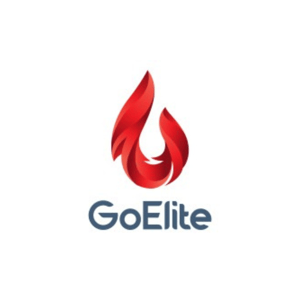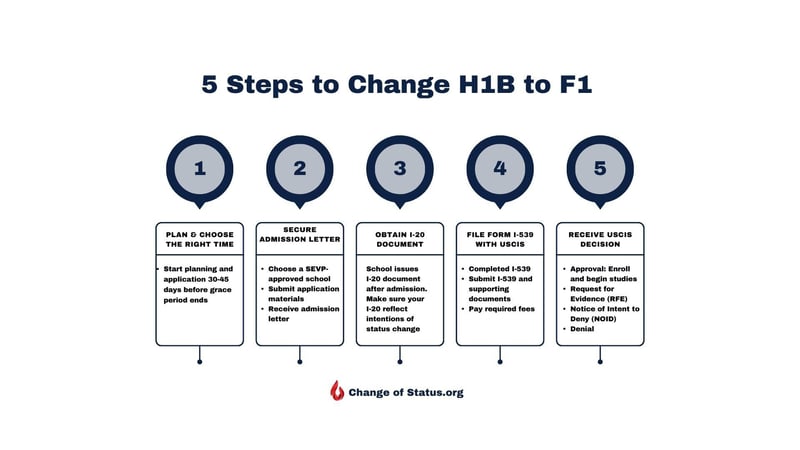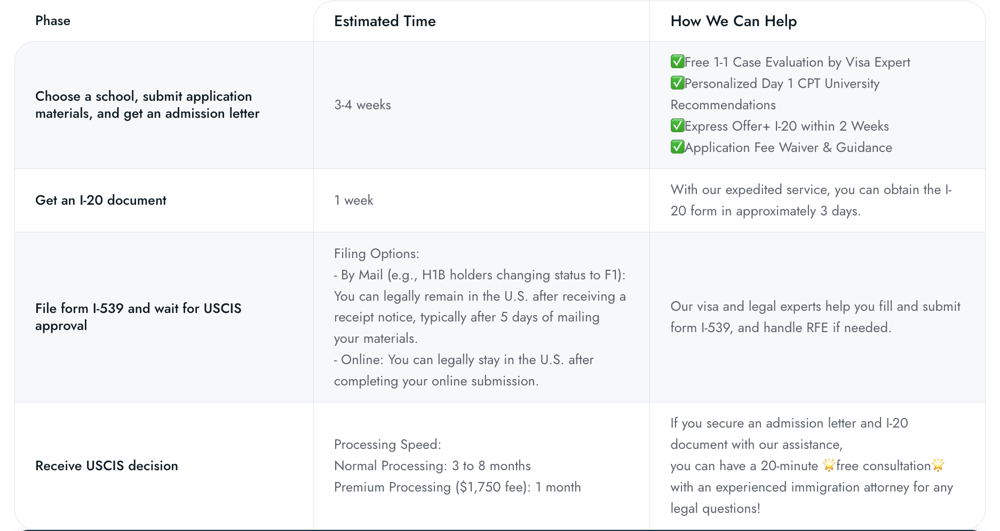.jpg?width=1920&height=1080&name=%E5%B0%81%E9%9D%A2%20(6).jpg)
Guide For H1B holders
H1B Max Out | Change of Status from H1B to F1 After 6-Year Limit
This guide explains how to navigate the complexities of H1B max out by changing your status from H1B to F1, allowing you to continue working with Day 1 CPT and safeguard your legal status in the U.S.
What to Expect
- Understanding H1B Visa
- What is H1B 6-Year Limit
- How does H1B 6-Year Limit Work
- What Happens After H1B 6-Year Limit
- Extending the H1B Visa With Green Card Application
- What Will Happen If Your H1B Expires With Perm Pending
- Navigating H1B Expiry With Perm Pending
- H1B Recapture: How it Works
- Change of Status from H1B to F1
- Leave the U.S.
- How to Change of Status from H1B to F1
- 5 Steps to Change Your Status to F1
- Processing Time
- Costs
- FAQs
Introduction
Navigating the complexities of U.S. immigration law can be daunting, especially when it comes to understanding the intricacies of the H1B visa and its six-year limit. The H1B visa allows U.S. companies to employ foreign workers in specialty occupations requiring theoretical or technical expertise, but it comes with a significant constraint: it is valid for a maximum of six years. This guide will show you how changing your status from H1B to F1 can help you continue work authorization and safeguard your legal status in the U.S. By exploring the process of enrolling in a Day 1 CPT university and transitioning to an F1 visa, you can effectively manage your career and stay in the United States even after reaching the six-year H1B limit.

Understanding the H1B Visa
What is H1B 6-Year Limit
The H1B visa is a non-immigrant visa that allows U.S. companies to employ foreign workers in specialty occupations that require theoretical or technical expertise. However, the H1B visa comes with a crucial limitation: it is valid for a maximum of six years. After this period, H1B holders must either change to another visa status, leave the country, or transition to permanent residency (also known as “green card”).
How does H1B 6-Year Limit Work
The H1B visa is initially granted for up to three years, with the possibility of extending it for an additional three years, making the total maximum duration six years. This six-year limit includes all the time you spend working in the United States under the H1B status.
However, it's important to note that only the time you are physically present in the U.S. counts towards this six-year limit. If you travel and spend a significant period outside the U.S., such as a year, that time does not count against your six-year cap.
This rule can provide some flexibility for H1B visa holders who may need to spend extended periods abroad for work or personal reasons. Understanding this aspect of the H1B visa can help you better manage your time and plan your stay in the United States.
What Happens After H1B 6-Year Limit
When approaching the H1B 6-year limit, it's crucial to understand your options to maintain your legal status in the U.S.
Extending the H1B Visa With Green Card Application
With green card application in place, H1B holders can extend H1B beyond 6 years. The key is to initiate the green card application process before your H1B visa expires. The green card process involves several important milestones: PERM labor certification, I-140 Immigrant Petition for Alien Worker, and I-485 Application to Register Permanent Residence or Adjust Status.
The process begins with the PERM labor certification, where your employer must demonstrate that no qualified U.S. workers are available for your position. Once PERM is approved, which can take approximately one to two years for individuals from countries like India and mainland China under current massive layoffs trend, you can then file the I-140 petition. If the I-140 is approved and your priority date is current, you can proceed to file the I-485 application.
Perm Stage
- You can ask for a one-year extension if your PERM application has been filed and will have been pending for at least 365 days by the end of your six-year H1B limit.
Example Scenario
- PERM Filed: July 15, 2023, and is pending.
- Current H1B Expiry: May 15, 2024.
- 6-Year H1B Limit (H1B recapture process - after accounting for time spent outside the USA): July 16, 2024.
- Extension Filing: Companies can file for an H1B extension in April 2024 to extend H1B status until July 14, 2025, based on the pending PERM.
Breakdown Analysis:
- PERM Application Filed: Your employer files your PERM application on July 15, 2023.
- Current H1B Expiry: Your current H1B status expires on May 15, 2024.
- 6-Year H1B Limit: The six-year limit of your H1B visa is July 16, 2024 (Your company needs to submit H1B recapture application to USCIS)
- Pending Period by Six-Year Limit: By July 16, 2024, your PERM application will have been pending for 367 days (from July 15, 2023, to July 16, 2024).
Extension Filing:
- Eligibility for Extension: Since your PERM application will have been pending for more than 365 days by the six-year limit (July 16, 2024), you are eligible for a one-year extension.
- When to File: Your company can file for the H1B extension in April 2024, a few months before your current H1B expires on May 15, 2024.
- Extension Duration: The extension can be requested to extend your H1B status until July 15, 2025, based on the pending PERM application.
I-140 Stage
H1B holders can extend their visa beyond the six-year limit in three-year increments if they have an approved I-140 petition but cannot file for Adjustment of Status or apply for an immigrant visa because an immigrant visa number is unavailable (i.e., the priority date is retrogressed). To obtain this extension, the employer must submit a copy of the I-140 approval notice, which shows that the priority date is not current. This extension can be granted even if the priority date becomes current after the petition is filed but before it is approved.
Example Scenario
- I-140 Approval: Your I-140 petition was approved on March 1, 2023.
- Current H1B Expiry: December 31, 2024.
- 6-Year H1B Limit (after accounting for time spent outside the USA): December 31, 2024.
- Extension Filing: Companies can file for an H1B extension in October 2024 to extend H1B status until December 31, 2027, based on the approved I-140 with a retrogressed priority date.
Breakdown Analysis:
- I-140 Approval Notice:
- Your I-140 petition was approved on March 1, 2023.
- Your priority date is retrogressed, meaning you cannot apply for Adjustment of Status or an immigrant visa.
- Current H1B Expiry:
- Your current H1B status expires on December 31, 2024.
- 6-Year H1B Limit:
- The six-year limit of your H1B visa is December 31, 2024.
- Eligibility for Extension:
- Since your priority date is retrogressed, you are eligible for a three-year extension.
- When to File:
- Your company can file for the H1B extension in October 2024, a few months before your current H1B expires on December 31, 2024.
- Extension Duration:
- The extension can be requested to extend your H1B status until December 31, 2027, based on the approved I-140 with a retrogressed priority date.
However, with the current landscape of economic downturn, particularly in the tech industry, the waiting times for green card approvals have increased, making it more critical to plan and act promptly. By understanding and navigating these stages effectively, you can ensure continuity in your U.S. employment and residence even after reaching the six-year limit of your H1B visa.
What Will Happen If Your H1B Expires Without PERM Pending for One-Year
If your H1B visa expires and you do not have an approved PERM labor certification, your options become more limited. Without the PERM approval, you cannot extend your H1B visa beyond the 6-year limit. In this scenario, you must either leave the United States or change to a different visa status that allows you to remain legally in the country, other visa options incl. Change of status from H1B to F1 student visa, H4 dependent visa, L1 visa, or O1 visa, etc.
Navigating H1B Expiry With PERM Pending
1. H1B Recapture: How It Works
H1B recapture is a provision that allows H1B visa holders to extend their stay beyond the six-year limit by reclaiming the time spent outside the United States during their H1B status. If you have traveled abroad for work or personal reasons, those days can be "recaptured" and added to your total H1B duration. To utilize this option, you must document all the periods you were outside the U.S. and present this information when applying for an H1B extension. This process can help extend your H1B status while waiting for your PERM approval, providing a temporary solution to avoid immediate expiration.
2. Change of Status from H1B to F1
Switching from H1B to F1 student status is a popular option among those nearing their H1B expiry with a pending PERM application. This pathway involves enrolling in a Day 1 CPT University, and changing to an F1 status, which allows you to remain in the country legally as a student, and extend your work authorization while you pursue a degree.
After changing H1B to F1 status, you can continue waiting for your green card process to progress while remaining on PERM pending. Once your PERM is approved, you can then change your status back to H1B and apply for an H1B extension. With PERM approval, you are eligible to extend your H1B status one year at a time.
If you are unfortunately laid off during this stage or if your PERM application fails, you can still use Day 1 CPT to search for a new job. This new employer could potentially file a new PERM application or sponsor you for a new H1B visa.
Compared to other visa options like H4 (dependent visa), L1 (intracompany transferee visa), or O1 (visa for individuals with extraordinary abilities), changing of status from H1B to F1 status is often preferred because it provides an easy and more flexible pathway to continue staying, studying and working in the U.S..
3. Leave the U.S.
If neither H1B recapture nor a change of status is feasible, you might have to leave the United States. In this case, you can seek opportunities in other countries or have your current employer continue the green card process from abroad. Once you receive the I-485 Employment Authorization Document (EAD) card, which allows you to work in the U.S. while your green card application is pending, you can re-enter the country. However, this option is less common and more challenging to execute in reality due to the complexities involved in securing a job and visa sponsorship from outside the U.S. Additionally, the uncertainty and potential delays in the green card process make this a less attractive option for many individuals.
Navigating H1B expiry with a pending PERM requires understanding these options and carefully planning your next steps to ensure you maintain your legal status and career trajectory in the United States.

While many SEVP-approved universities are available, Day 1 CPT programs may be the most attractive choice for those transitioning from H1B to F1 status.
- Immediate Employment: Day 1 CPT schools allow F1 students to use CPT for full-time or part-time employment, on-campus or off-campus jobs, starting from their very first day of studies. Most traditional schools require F1 students to complete one academic year before becoming eligible for CPT, and during semesters they can only work up to 20 hours per week, with 40 hours allowed during breaks. Day 1 CPT schools provide F1 students more opportunities to work, gain experience, earn income to reduce financial pressures right from the start of their program.
- Affordable Tuition: Day 1 CPT programs typically have lower tuition fees compared to traditional degree programs, making them a more cost-effective option.
- Flexibility: Many Day 1 CPT schools have multiple enrollment windows throughout the year, allowing for a quicker transition from H-1B to F1 status.
- Streamlined Admission Process: The admission process for Day 1 CPT programs is often more straightforward and quicker than traditional degree programs, enabling you to obtain the required documentation for your F-1 visa application faster.
- Lower Course Load: Day 1 CPT programs generally have a lighter course load compared to traditional master's programs, allowing you to balance your studies with practical training or other commitments.
- Legitimacy: Day 1 CPT programs are recognized by the USCIS as a legitimate path to F-1 status, reducing the likelihood of your intent being questioned during future green card or visa change processes.
Therefore, Day 1 CPT schools provide a more direct and focused path to maintaining legal status in the United States while gaining practical experience in your field.
Not all Day 1 CPT universities can take change of status application. Check out our blog post "Top 5 Day 1 CPT Universities for Changing Your Status to F1" to learn about your Day 1 CPT options.

Processing Time
Processing time varies from 3-8 months, but depends on your processing method and specific case:
-
Standard Processing: The processing time typically ranges from 3 to 8 months, depending on individual circumstances. It’s advisable to work closely with your school’s Designated School Officials (DSOs) to plan your application timeline effectively. Avoid traveling abroad while your application is pending, as this could complicate your case.
-
Premium Processing: For a faster response, you can opt for premium processing, which guarantees a response from USCIS within 30 calendar days once all required materials are submitted. If the gap between your application and the F1 program start date is short, premium processing is a viable option to expedite the process.

Costs
- School application/registration fee: $100-$200 (varies by school/program)
- I-901 SEVIS fee: $350
- Form I-539 filing fee: $420/$470
- Tuition fee: Due after the change of status is approved